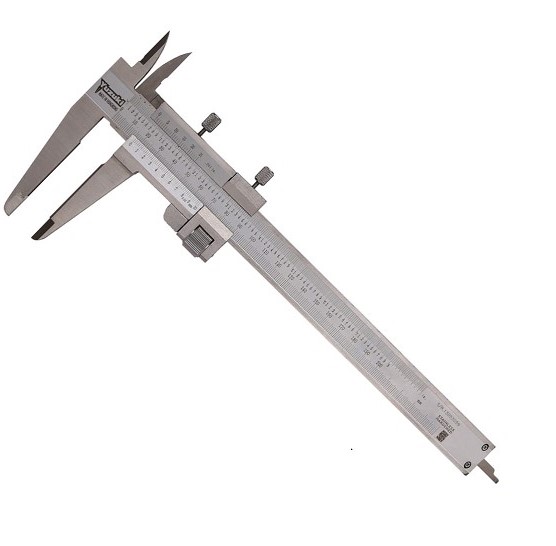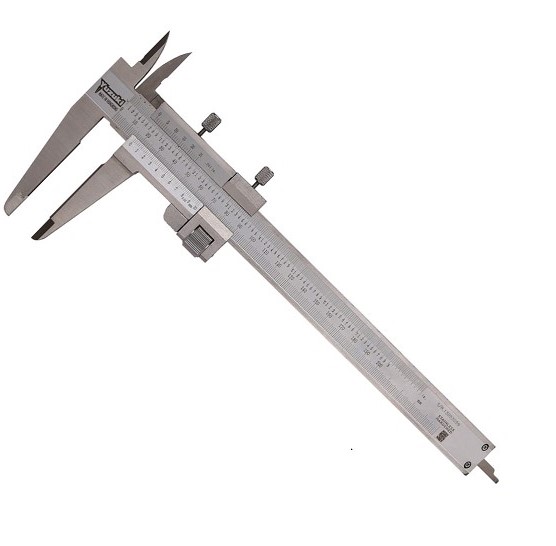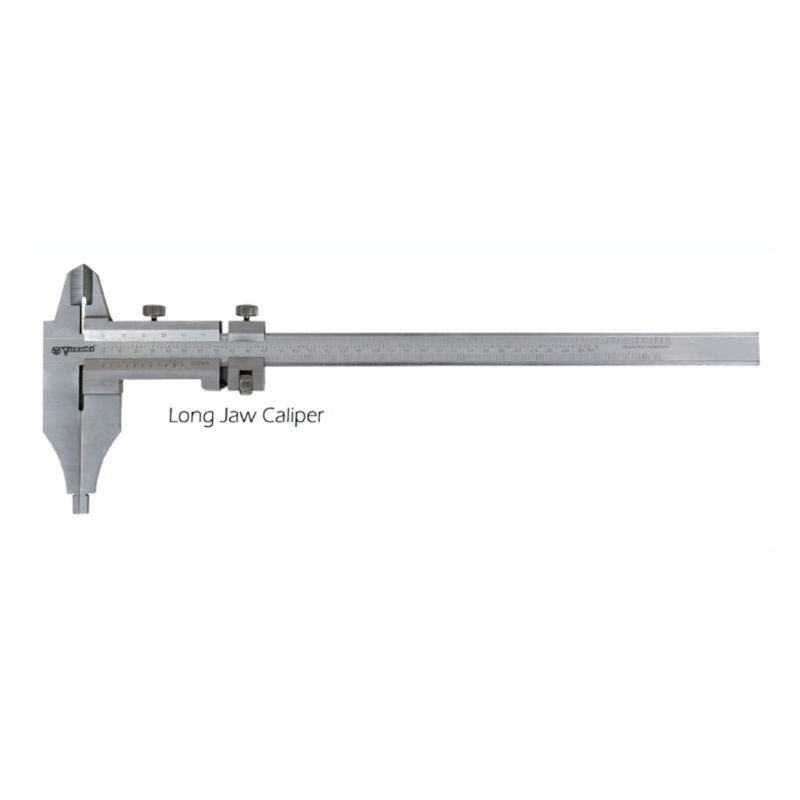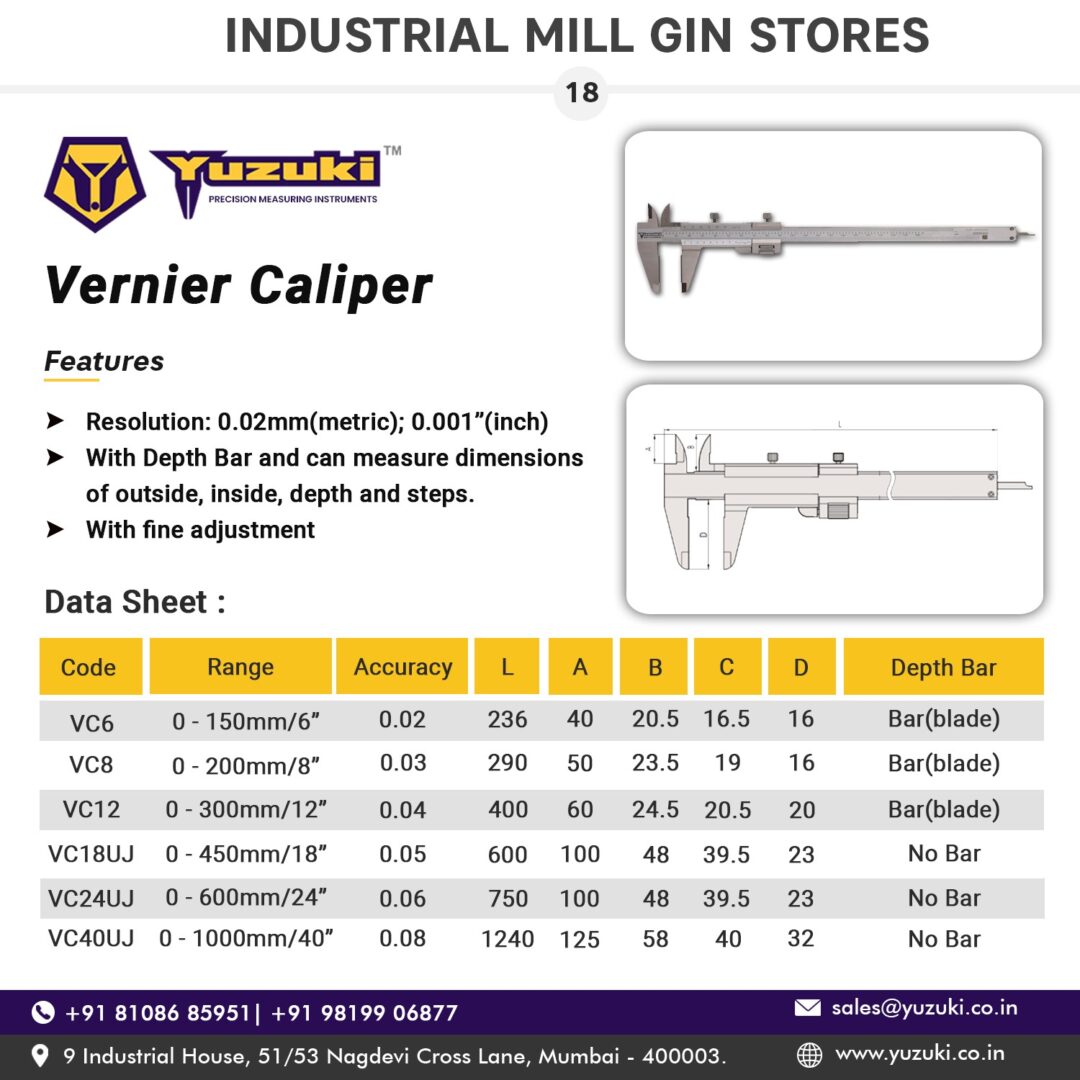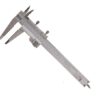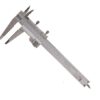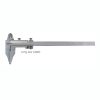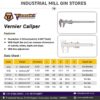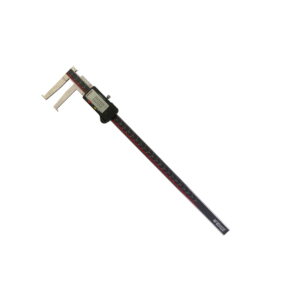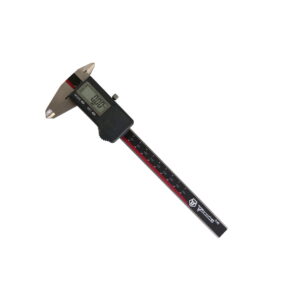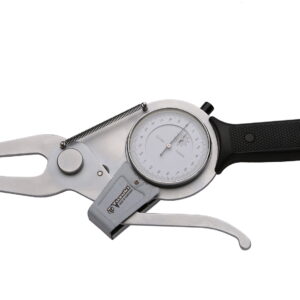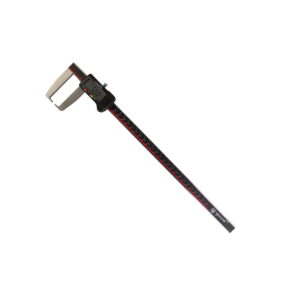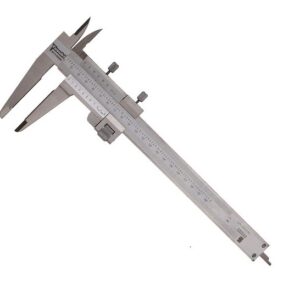| Brands | Yuzuki |
|---|---|
| Range | 150mm, 200mm, 300mm, 450mm (Upper Jaw), 600mm (Upper Jaw), 1000mm (Upper Jaw) |
Vernier Caliper with Fine Adjustment
₹1,700 – ₹22,500
Product Features
- Resolution: 0.02mm (metric) / 0.001” (inch) for high-precision measurements.
- Range: Available in sizes from 150mm to 1000mm to suit various measurement needs.
- Versatile Measurement: Includes a depth bar for measuring outside, inside, depth, and step dimensions with ease.
- Fine Adjustment: Equipped with fine adjustment for enhanced accuracy and precision during measurements.
Ensure precise measurements with the YUZUKI® Vernier Caliper, designed for professionals in engineering, machining, and quality control. Ideal for measuring internal, external, and depth dimensions, it offers accuracy, durability, and reliable performance for inspection and calibration tasks. Perfect for workshops and laboratories, the YUZUKI® Vernier Caliper is a trusted tool for precision measurement
Download Catalog
View Catalog
Access the Complete Collection Catalog from YUZUKI®
View Complete Catalog
Product Details
YUZUKI® Vernier Caliper is a precision measuring instrument widely used in engineering, machining, and manufacturing to measure the dimensions of objects with high accuracy. This versatile tool features two sets of jaws for external and internal measurements, along with a depth gauge. The Vernier scale enhances the caliper’s precision by allowing users to read measurements down to fractions of a millimeter or inch. With its ability to measure thickness, diameter, and depth, a Vernier caliper is an indispensable tool in environments where exact dimensions are crucial. This tool is ideal for professionals and hobbyists alike, ensuring reliability and precision in every project.
| Sr. | Code | Range Available |
|---|---|---|
| 1 | VC6 | 0 – 150 mm |
| 2 | VC8 | 0 – 200 mm |
| 3 | VC12 | 0 – 300 mm |
| 4 | VC18UJ | 0 – 450 mm |
| 5 | VC24UJ | 0 – 600mm |
| 6 | VC40UJ | 0 – 1000 mm |
Key Features and Benefits
- High Precision and Accuracy: Vernier calipers provide accurate measurements down to 0.02 mm or 0.001 inches, making them suitable for tasks requiring precision.
- Dual Measurement Capability: The caliper can measure both external and internal dimensions, as well as depth, providing comprehensive measurement capabilities.
- Durable Construction: Made from high-quality stainless steel or hardened materials, Vernier calipers are built to withstand wear and tear in rigorous work environments.
- Easy-to-Read Vernier Scale: The finely marked Vernier scale ensures clarity, allowing users to take measurements quickly and efficiently.
- Locking Screw for Stability: The locking screw on the caliper keeps the jaws in position, ensuring measurements remain steady for consistent results.
- Portable and Lightweight: Compact and lightweight, Vernier calipers are easy to carry and handle, making them suitable for both field and workshop use.
Applications
Vernier calipers are versatile tools used across various industries and applications:
- Manufacturing and Engineering: Essential for measuring and verifying part dimensions during production and quality control.
- Machining: Used to measure workpieces accurately, ensuring components fit and function properly in assemblies.
- Scientific Research and Laboratories: Helps measure specimens and components accurately, supporting precise experiments and data collection.
- DIY Projects and Hobbies: Popular among hobbyists for model making, jewelry design, and other projects requiring detailed measurements.
- Automotive and Aerospace: Used in inspecting and measuring parts critical to safety and performance in automotive and aerospace components.
The Vernier Caliper is a versatile and reliable tool that meets the high standards of professionals across various fields. Its accuracy, ease of use, and durability make it a valuable investment for anyone committed to precise measurements in their work.
How to Use
A Vernier caliper is a versatile and accurate tool for measuring dimensions such as length, diameter, and depth. Here’s a simple guide to using a Vernier caliper effectively and obtaining precise measurements every time.
Step-by-Step Instructions
- Understand the Parts of the Vernier Caliper
- A Vernier caliper has two main scales: the main scale and the Vernier scale. It also has two sets of jaws (for external and internal measurements) and a depth probe.
- Zero the Caliper
- Before taking a measurement, ensure the caliper is zeroed by closing the jaws completely and checking that the reading is at zero. If not, adjust it to avoid measurement errors.
- Select the Measurement Type
- External Measurements: Use the larger jaws to measure the outside dimensions of objects like rods or blocks.
- Internal Measurements: Use the smaller, upper jaws to measure the inside dimensions of holes or slots.
- Depth Measurements: Extend the depth rod from the bottom of the caliper to measure depths of holes or recesses.
- Position the Object and Take the Measurement
- Place the object between the jaws or on the depth probe, depending on the measurement type. Carefully close the jaws or extend the depth rod until they touch the object lightly but firmly.
- Read the Main Scale
- The main scale will give you the whole number measurement in millimeters or inches. Take note of the point where the zero mark on the Vernier scale aligns with the main scale.
- Read the Vernier Scale for Precision
- Look along the Vernier scale to find the line that best aligns with a mark on the main scale. This line indicates the additional fraction of the measurement, providing precise results down to 0.02 mm or 0.001 inches.
- Combine the Readings
- Add the main scale reading to the Vernier scale reading to obtain the final measurement. For example, if the main scale reads 10 mm and the Vernier scale reads 0.02 mm, the final measurement is 10.02 mm.
Tips for Accurate Measurements
- Apply Consistent Pressure: Use gentle, consistent pressure when closing the jaws on the object to avoid distortion.
- Avoid Tilting the Caliper: Keep the caliper straight and parallel to the measurement surface for accurate readings.
- Keep the Caliper Clean: Dirt and debris can affect accuracy, so keep the caliper and the object clean.

